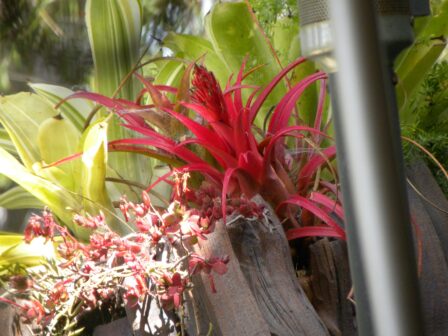Part I Bromeliads
Easy to grow and Easy on the Eye
In April, Joann Dossett, long-time member of the Mission Hills Floral Association, San Diego Horticultural Society, and a host of other botanical organizations, gave an enthusiastic workshop on bromeliads at her beautiful home. She began by apologizing. It seems a troop of raccoons has fallen in love with her garden (They do have good taste!), and the night before thirty people were to arrive to see her lovely yard, these midnight marauders destroyed a sizable portion of its upper-most section. Despite the trauma to the garden, Dossett gave a very informative talk and demonstration.
Dossett concentrates on only a few requirements when choosing a plant: she must love its look, and it must have low water needs and be low maintenance. While it is nice to know the name of the plant, she says, “It is not a requirement.”
As she showed us one beautiful plant after another, Dossett pointed out how easy they are to grow. Our climate so near the coast is ideal for most bromeliads, and they can be part of the landscape. In other words, we needn’t keep them indoors in pots. Dossett maintains, “They may actually do much better outside in the ground rather than indoors in pots.” Bromeliads don’t need to be fed, they thrive with very little water, and bugs do not like them. “Why wouldn’t everyone want a yard full of plants that do not need to be fertilized, sprayed for bugs or diseases, and need to be watered no more than once a week with a quick spray of the hose?” she wonders. However, Dossett reminded us, “Raccoons love them.”
Many of Dossett’s plants live in pots buried in the ground. This way she can move them easily or remove the pot to divide the plants which she rarely does. She prefers to let her bromeliads propagate creating masses, thus satisfying her artistic sense of design. The key to a healthy plant is to find a spot it likes. Dossett moves it until she finds a spot where it thrives, and there it will remain.
Bromeliads like light, but light and temperature needs depend on the individual plant. Generally it is easy to tell what a bromeliad needs. Soft-leafed plants without spines prefer only indirect light and moderate temperatures, 55 to 85 degrees, and ideally, some humidity. Plants with fairly stiff leaves and spines which “bite,” as Dossett describes them, will be happy with lots of indirect light, and some plants will tolerate a bit of direct sun as long as it is not hot, mid-day sun.
All bromeliads need excellent drainage, and some, especially Tillandsias, need no soil at all. Those growing with no soil need to be anchored to something so they do not blow away; Dossett finds that bromeliads growing in soil grow bigger and more rapidly. The ideal soil for these plants is a combination of medium-sized orchid bark and large-sized perlite in equal amounts mixed well. If you do not have time to plant them properly, Bromeliads can sit in empty pots for months.
Most bromeliads like their cups (the center of the plant) flushed with fresh water regularly. Even a plant that appears dead from lack of water will revive if soaked overnight in filtered water (not distilled or tap). Allowing the soil to become soggy will very likely cause the plant to rot,” she warns. Depending on the weather, Dossett gives her plants a brief shot from the hose. Like any plant, the hotter the weather, the more water they need. The leaves will curl inward if the plant needs water. Do not over-water your plants.
Bromeliads come in a variety beautiful shapes and colors. Luckily their leaves are beautiful. They look good all year long, but for Dossett their blooms are “just an added attraction.” Most bromeliads bloom once in a life-time. Luckily, the blooming means the mother plant will produce pups. She will die slowly, leaving her babies to continue her genetic line. To encourage blooming and great color, provide lots of light. When the time comes to separate mom from her pups, Dossett is adamant that before attempting this, you should attend a Bromeliad Society meeting to find out how to do this properly. Otherwise, she warns, “very likely you will kill them.”
The Latin name for bromeliads is Bromeliacae. There are three subfamilies: Bromclioeae, Pitcairniodeae, and Tillandsioiddeae. Most Bromclioeae are epiphytes which grow on objects such as wires, other plants, and even on buildings. Their nutrients come from air and rain (or a hose). Some are terrestrial or plants that grow on land. One of these sub-families is the pineapple.
Most Pitcairniodeae grow on land or rocks and are often found in arid and mountainous areas. They have spiky leaves and resemble agaves. Even though they will grow in soil, they do need good drainage.
These are easy plants to grow. As soon as I left Dossett’s house, I ran home to one of my bromeliads (according to the plant’s label). Like many store-bought plants, this one had been planted in potting soil. In the short time it had been mine, the mother plant had bloomed, begun dying, and had produced two babies. I immediately took the entire family out of its pot, shook off the soil, waited a few days, shook off the rest of the soil, set it in an empty pot and gave the center a quick drink from the hose. Soon I shall plant it in the bark and perlite mixture. Meanwhile, it seems content.
This month’s meeting will be May 22 with Amy Huie speaking on “How do your native plants grow?” Meetings are from 6 to 8 p.m. at the church at 4070 Jackdaw. Members are free; guests pay $10.00. Don’t forget to buy your tickets for the 14th annual Mission Hills Garden Walk on Saturday, May 11 from 10 a.m. until 4 p. m.
Category: Entertainment, Local News








